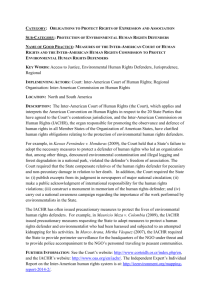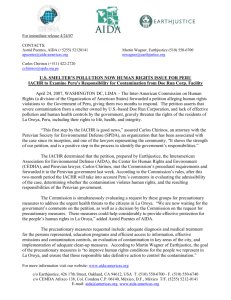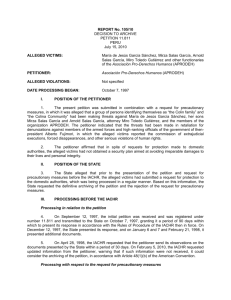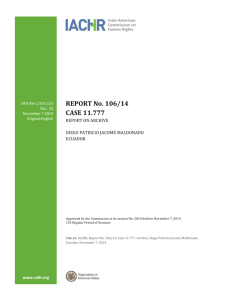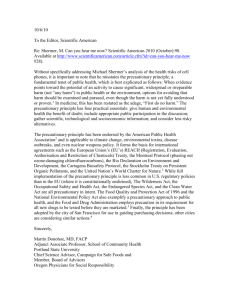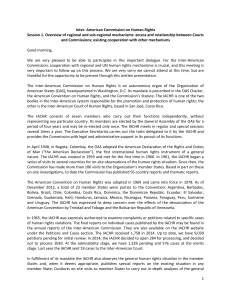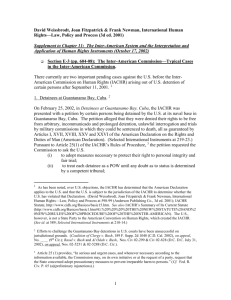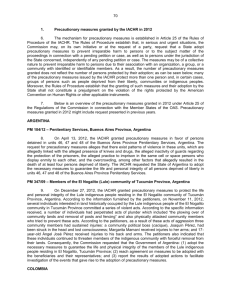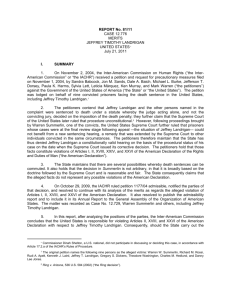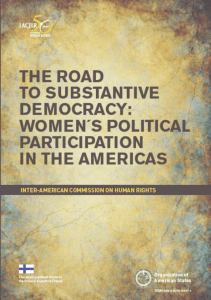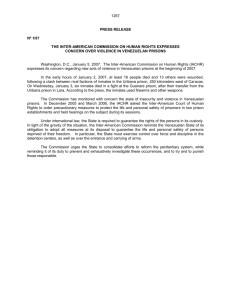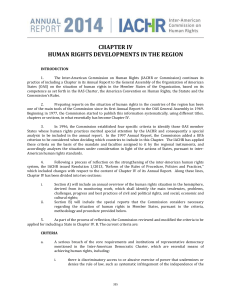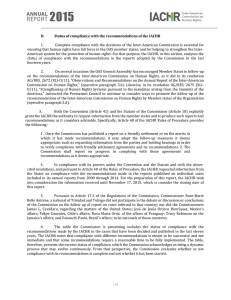1 - PERMANENT COUNCIL OF THE OEA/Ser.G ORGANIZATION OF
advertisement
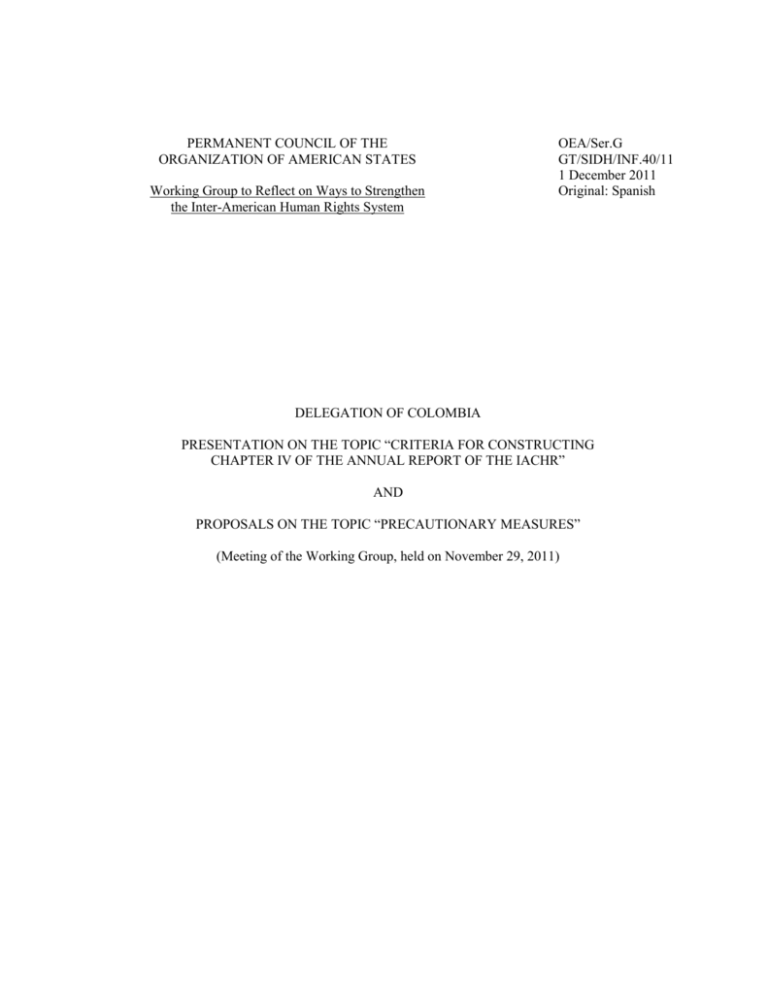
PERMANENT COUNCIL OF THE ORGANIZATION OF AMERICAN STATES Working Group to Reflect on Ways to Strengthen the Inter-American Human Rights System OEA/Ser.G GT/SIDH/INF.40/11 1 December 2011 Original: Spanish DELEGATION OF COLOMBIA PRESENTATION ON THE TOPIC “CRITERIA FOR CONSTRUCTING CHAPTER IV OF THE ANNUAL REPORT OF THE IACHR” AND PROPOSALS ON THE TOPIC “PRECAUTIONARY MEASURES” (Meeting of the Working Group, held on November 29, 2011) DELEGATION OF COLOMBIA PRESENTATION ON THE TOPIC “CRITERIA FOR CONSTRUCTING CHAPTER IV OF THE ANNUAL REPORT OF THE IACHR” AND PROPOSALS ON THE TOPIC “PRECAUTIONARY MEASURES” (Meeting of the Working Group, held on November 29, 2011) I. Concerns 1. 2. 3. 4. 5. 6. 7. 8. 9. 10. II. How the decision to include or exclude a country under Chapter IV is made. What type of quorum for decision-making is required for this purpose? What is the existing methodology for constructing Chapter IV? What kinds of variables are taken into account? Does the Commission consider, for example, the number of IACHR press releases on a certain country, the number of hearings on that country, the number of cases declared admissible and/or, even more importantly, the status of implementation of the Commission’s recommendations, commitment to the System and in particular to the IACHR, as well as attendance at hearings, transmission of information, etc.? Who in the Commission is responsible for constructing Chapter IV? Is there a higher body for review? How many people does the Commission devote to constructing Chapter IV and how intensive is their schedule? How many months does the Commission spend preparing it? What kinds of sources does the Commission choose (information from: NGOs, journalists, states (the ones concerned and others), original research, press, etc. What kind of exercise does the Commission use to verify them? Does the Commission have a structure to systematize suppliers of reliable information? Is there regular tracking of the information? Does the Commission issue a special call for information (a specific period) or does it construct the report with correspondence received throughout the year? What steps does the Commission take to ensure the information is up to date? What level of dialogue is there with the state concerned regarding construction of the report? Points to note Emphasize that, in keeping with operative paragraph 11 of 2011 resolution AG/RES. 2672 (XLI-O/11), there is consensus on the following mandate: “To call upon the IACHR to continue the dialogue with the member states and other users of the system on the methodology used to develop the information presented in Chapter IV of its annual report, inviting joint reflection on how to improve the efficacy of this mechanism.” -2- A. On the Methodology Some commissioners have already acknowledged that the methodology needs revising. To illustrate this point, we shall quote Commissioner Luz Patricia Mejía who stated in Chapter IV of the last Annual Report, in the segment on Colombia: In the case of Colombia and the other countries included in Chapter IV, I think other countries in similar or worse circumstances in the region have not been properly analyzed. To that end, I believe the methodology that has been in use does not provide elements to accurately measure the situation of every country of the region and in particular an impartial and fragmented view of the fulfillment of the human rights obligations by the states of the region. While the five criteria for including a country in Chapter IV of the annual report are clearly defined, Colombia notes with concern that the problems outlined in those criteria are common to the region and not exclusive to countries that are currently the focus of “special attention” by the Commission. It is worth noting that over the last 4 years the Commission has steadily increased the number of annual hearings devoted to the human rights situation in the region. In addition, based on a careful analysis of the Commission’s annual press releases, releases issued at the end of end of the sessions, and the number of times that countries are required to attend hearings, it can be concluded that the concerns of the IACHR go beyond the countries currently included in Chapter IV. That regional approach is not reflected in the structure of the annual report, however, as 40% of its content pertains to the chapter in question, which reviews only a few countries. Moreover, the remaining content of the report contains statistics, detailed information on the activities of the IACHR, and details of the cases, which does not allow for an analysis of the human rights situation in the Hemisphere. From the foregoing it can be concluded that the report needs to be made universal. Reform of the United Nations human rights protection system has delivered positive results, thanks to the shift from the selective, biased process – one example of which is the fact that the states parties submit to the UN Universal Periodic Review. Keeping the current discriminatory assessments carries the dual risk of them being arbitrary in terms of the states specified, on the one hand, and, on the other hand, serious problems are ignored in all the other states that have been excluded, and so objective regional analyses to enable joint implementation of solutions to shared problems cannot be conducted. It is worth noting that this view has already been brought out in the operation of other inter-American mechanisms. One proposed solution would be to stick to the provision in paragraph 1.a of Article 59 of the Rules of procedure of the IACHR, which states that the Annual Report shall include “An analysis of the human rights situation in the Hemisphere, along with recommendations to the States and organs of the OAS as to the measures -3- necessary to strengthen respect for human rights.” Its very title, “DEVELOPMENT OF HUMAN RIGHTS IN THE REGION,” contradicts the contents of Chapter IV. B. On the Effectiveness The Commission currently produces invaluable thematic and country reports, besides the monitoring work, activities, reports, and press releases regularly done by the IACHR Rapporteurships. The annual report of the IACHR must be a system of alert and recommendations for the Hemisphere. Such an approach would contribute effectively to the goal of promoting fulfillment by states of their obligations and commitments in the area of human rights, ensuring universality, equality of treatment of states by the IACHR, objectivity, and non-selectivity, eliminating the use of double standards and politicization, with a constructive, dialogue-based approach. 1. On the process of preparing the report Emphasize the importance of ensuring compliance with paragraph 2 of Article 59 of the current Rules of Procedure of the IACHR, which establishes that a copy of general, special, or follow-up reports shall be sent to the respective state, giving it the option of making any pertinent observations, which, as is the current practice, should be published in the final version of the report, in the same place and with the same degree of visibility given to other sources. This is the only way for the IACHR to afford official information provided by the state equal and fair treatment. In that same vein, it would be appropriate to extend the deadline to respond to these reports, given that by their nature they require extensive consultation with the relevant national authorities as well as consolidation of information within the state. PRECAUTIONARY MEASURES Specific Proposals by Colombia 1. Precautionary measures must be requested of states on a case by case basis and as determined by the beneficiaries. 2. The IACHR should verify, in accordance with the regulations and prior to adoption of any precautionary measure, that there is corroborating evidence that the beneficiary has given the petitioner seeking the precautionary measure on his or her behalf a mandate to represent him or her. 3. Clearly and adequately justify new precautionary measures according to each specific situation. 4. Specify period of validity of precautionary measures, to indicate that when it expires, the measure also expires or is reviewed. -4- 5. Establish criteria for lifting precautionary measures, including specific provisions on the obligations incumbent upon the petitioners and beneficiaries thereof. 6. Establish with the states a work plan and timetable to conduct a progressive review of current precautionary measures, so as to individualize beneficiaries and assess the beneficiary’s status and risk situation, with a view to possibly removing the precautionary measures. 7. Implement a mechanism for managing precautionary measures to expeditiously channel information between petitioners and the state, do more in-depth review of the content of correspondence, and clear up doubts arising about beneficiaries. 8. Establish a mechanism for closing information requests. 9. Establish reasonable deadlines for both parties, especially in cases relating to new requests for information or precautionary measures. It is important to unify deadlines for the state and for the petitioners. CP27673E04
